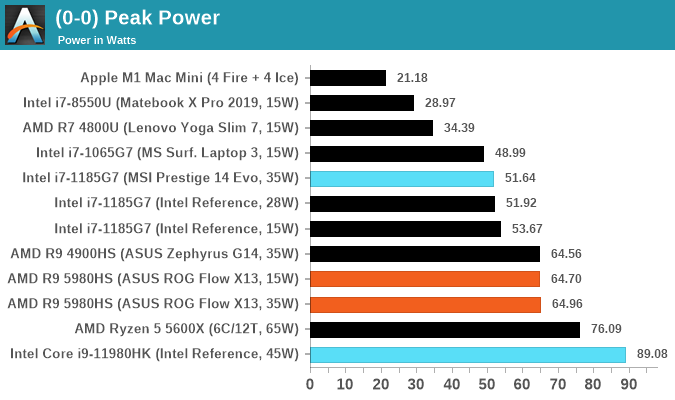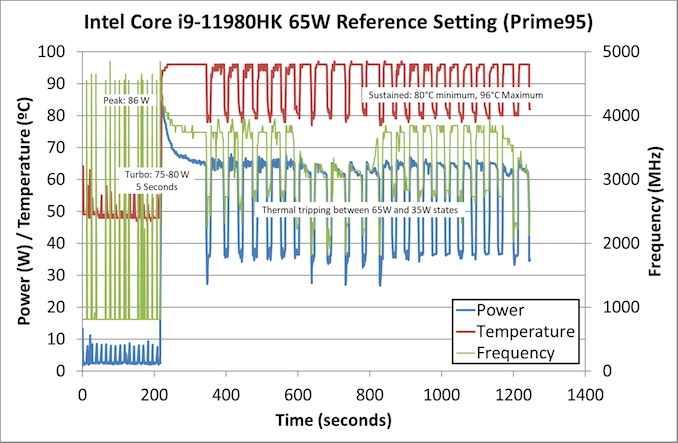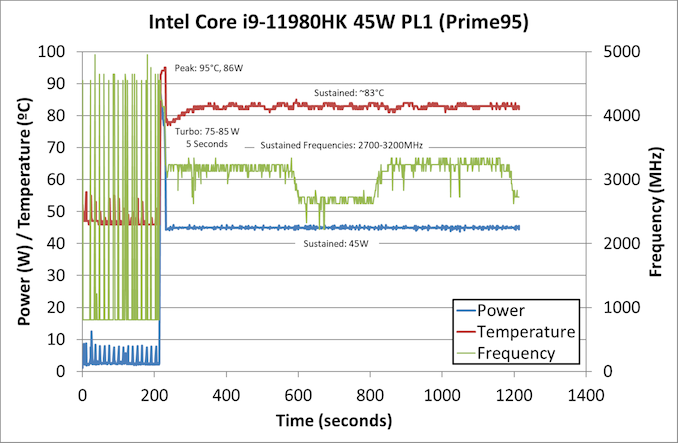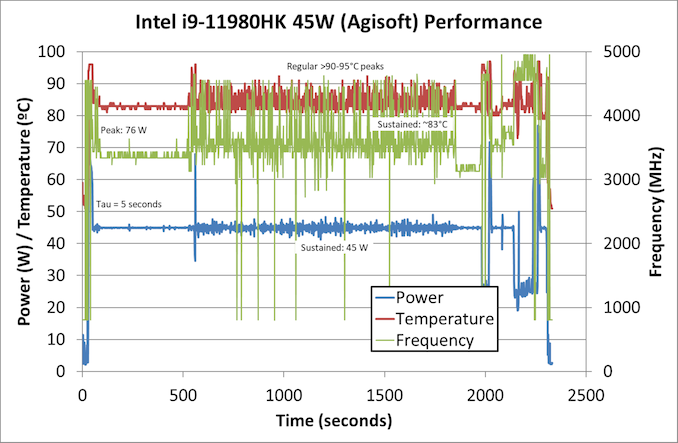Intel 11th Generation Core Tiger Lake-H Performance Review: Fast and Power Hungry
by Brett Howse & Andrei Frumusanu on May 17, 2021 9:00 AM EST- Posted in
- CPUs
- Intel
- 10nm
- Willow Cove
- SuperFin
- 11th Gen
- Tiger Lake-H
Power Consumption - Up to 65W or not?
TDPs and power consumption has been a topic we’ve been revisiting on an (unfortunately) regular basis on almost every product launch. Over the last few generations of product launches in particular, we’ve been attempting to explain the current industry situation in more depth in order to demystify marketed power and thermal envelope figures versus what you can actually expect to encounter in the real products.
Given our limited time in writing up this Tiger Lake-H system, I’ll refer back to our more extensive articles, in particular the in-depth explanation of TDPs and Intel’s new generation product behaviour in our review of the Tiger Lake reference platform last September:
Alongside that piece, we also want to point out more extensive historical talks about TDPs, Turbo and power consumption:
- Why Intel Processors Draw More Power Than Expected: TDP and Turbo Explained
- Talking TDP, Turbo and Overclocking: An Interview with Intel Fellow Guy Therien
- Reaching for Turbo: Aligning Perception with AMD’s Frequency Metrics
- AMD Ryzen 9 5980HS Cezanne Review: Ryzen 5000 Mobile Tested
In the context of today’s Tiger Lake-H reference laptop and system, the one thing we must preface the rest of the review is the power settings the laptop came in and the resulting behaviour and thermal characteristics of the Core i9-11980HK SKU we’ll be reviewing today.
Intel’s reference laptop, out of the box as delivered to us by Intel seemingly was set up with no PL1 limit, or at least what we suspect is the maximum cTDP limit of 65W of the i9-11980HK. Generally speaking, this is no surprise as TGL-H is targeting the high-power desktop replacement laptop market which tends to come with capable and extensive thermal dissipation designs.
At first, we started running our tests on the platform in this default reference setting, representing what we had hoped being the best-case scenario for the chip and platform, until we discovered some concerning thermal behaviour when under full load:
Under a Prime95 load in a more prolonged test period of 10+ minutes, when tracking package power consumption as well as CPU temperatures and frequencies, we’re seeing that the TGL-H reference laptop is having great troubles at sustaining this default 65W TDP mode.
During the initial idle period we see the CPU has low power consumption in the 2.2W range with some workload noise in the mix, boosting the CPU frequencies up to 4.9GHz.
The initial load ramp results in peak power consumption of up to 86W, but this is a very transient measurement as power quickly throttles down to 70W and below within seconds. In our readouts it seems that Tau (PL2 turbo period) seems to be set at 5 seconds for this machine.
The worrying behaviour starts happening after around 2 minutes of load: we indeed see the CPU package generally trying to limit itself to around 65W, however it’s not a constant steady state, with very obvious large fluctuations between 65W and 35W.
Looking at the temperature, we’re seeing maximum load figures in excess of 95°C, with some 96°C peaks in our coarse sampled data. What seems to be happening here is that the CPU is thermal tripping between the 65W and 35W states, unable to sustain the 65W state for any amount of prolonged time.
We’ve confirmed that this throttling and power and frequency fluctuations happen on several workloads, and the only conclusion we can come to is that the reference system simply doesn’t have an adequate enough thermal dissipation solution to effectively enable the 65W cTDP mode of the CPU.
While the reference laptop had a bare-bones BIOS, fortunately enough we were able to rely on XTU to change the system’s PL1 settings, and we chose to re-test at 45W given that this is the i9-11980HK’s supposed default TDP setting.
Under this simple change, the thermal, power and frequency response of the system appears to be much more reasonable. We’re still seeing peak power consumption figures of 75-86W which should correspond to the PL2 figures of the chip, but again that’s only for short workloads which fit into the 5 second Tau/Turbo period.
For the remainder of the next 15 minutes, the machine was able to sustain a steady state CPU temperature of around 83°C, and power consumption capped at 45W. Frequencies ended up around 3200MHz all-core for most of the test but had a prolonged 2700MHz period a few minutes in. The 11980HK has an advertised base frequency of 2600MHz, so that seems to be in line with Intel’s specifications.
Unfortunately, we don’t have Intel’s previous generation H-Series processors in house for a direct generational comparison, but the next best thing is the 11980HK’s nearest competitor, AMD’s Ryzen 9 5980HS. This latter chip comes with a 35W TDP which is 10W lower than the new TGL-H SKU we have in house right now, and we see an obvious difference between the chip’s long-term thermals and power, ending up at different levels after some while.
The Ryzen 9 has a prolonged 300s semi-turbo state where it sustains 42W power until thermal saturation of the laptop. During this period, with similar power consumption to the 11980HK and also quite similar thermal results of around 80-83°C, both platforms seem to be quite similar – except for the fact that AMD Zen3 cores able to operate at all-core boost frequencies of around 4GHz, while the Willow Cove cores of the TGL-H system operate at around 3200MHz and below. This is an important metric to note as we dive deeper in other results of our test suite.
In more real-world full load workloads such as Agisoft, we’re seeing the i9-11980HK being able to have more aggressive boost frequencies due to the more dynamic and differentiated nature of the workload. Boost frequencies during the heft of the workload reach up to around 4.5GHz which is what Intel advertises as the nT turbo of the chip, while the rough average sits at around 3.5GHz. Towards the end of the test, we’re seeing lower core count boost frequencies reaching the near 5GHz 1-2T advertised boosts of the cores.
Still, what’s relatively concerning is that temperatures are still quite high even when tested in the 45W PL1 mode, we still see temperatures well in excess of 90°C and peaking at >95°C for transient periods.

In terms of peak power comparisons, we see that the chip goes up to quite high transients, and has PL2 configurations of around 85-90W. Due to Tau and the turbo period here being only a mere 5 seconds, it shouldn’t affect thermals too much, and should give the system very good responsiveness, even though it will come at the cost of power and battery life.
Unfortunately, due to the embargo and extremely limited time we’ve had with the system we haven’t yet tested more power scenarios, such as 35W cTDP-down or unplugged battery-only behaviour of the platform. We’ll be following up with updates after today’s initial review.














229 Comments
View All Comments
Bagheera - Tuesday, May 18, 2021 - link
Intel isn't gonna have enough EUV in time to ramp 7nm by 2023. they are in serious trouble and floating on borrowed time, most analysts just aren't aware.https://semiwiki.com/forum/index.php?threads/will-...
Intel's 10nm is indeed competitive with TSMC 7nm in terms of density, but AMD will be moving to 5nm with Zen 4 next year, what can Intel's response be? They can increase outsourcing to TSMC but that means less utilization of their own fabs which is bad. They absolutely won't be able to get 7nm ready in time to compete with AMD on TSMC 5nm. It will be back to the status quo of Intel lagging behind AMD by one full node, and likely foregoing power efficiency for performance parity.
Bagheera - Tuesday, May 18, 2021 - link
no actual semiconductor professional expected Intel 10nm to surpass TSMC 7nm in any tangible way. the only people who expected otherwise are uniformed enthusiasts (usually gamers, who the to be partial to Intel)The gap will only widen from here. Intel really shot itself in the foot with bad EUV planning.
https://semiwiki.com/semiconductor-services/ic-kno...
watzupken - Tuesday, May 18, 2021 - link
I feel this review concludes that Intel have effectively lost their competitive edge when their fab started to lag behind. In fact, its also conclusive that the SuperFin is really nothing super at all even when compared to TSMC's 7nm. Its just 10nm on steroids just like what they have been doing to their 14nm. From an architect standpoint, Willow Cove is decent, but the bulk of the performance is due to pushing for very high clock speed at the expense of very high power consumption. If this was released on a desktop, it will be a hit. But on mobile, I don't think one can easily find a laptop that have the cooling capability to tame the heat output and also maintain a decent battery life. Especially this processor will likely be paired with a high end GPU. To me, this is a worrying trend for Intel because they will likely have to stick around with 10nm for another couple of years at least. If their new CPU architect is unable to provide decent IPC gains without bursting the power limit, they will surely be in trouble, especially when AMD's 5nm chips may appear in the market first.mode_13h - Tuesday, May 18, 2021 - link
> If this was released on a desktop, it will be a hit.Yes.
> I don't think one can easily find a laptop that have the cooling capability
> to tame the heat output and also maintain a decent battery life.
At 35 W, it would probably make a fine laptop. Unfortunately, competitive pressure is pushing Intel to juice their CPUs more than they really should.
sandeep_r_89 - Tuesday, May 18, 2021 - link
Can you please please stop using the word BIOS for modern devices? Pretty much all devices have been on UEFI only for several years now.Silver5urfer - Tuesday, May 18, 2021 - link
Ah the M1 fastest CPU ever, doesn't make it to SMT SPEC scores for some reason, like always. Don't worry we will see the Apple CPU which would be X version of the chip iteration when it finally catches up to the SMT of these SMT until then M1 is the best CPU ever.TGL machines will throttle to peak with the thin and light garbage heatsinks. That's a given, people should stop buying these parts. Laptop batteries will be destroyed eventually and none of them will have the Dell Desktop Power plan only Workstations have that feature (Lenovo and Dell), Alienware used to have, not sure about now their A51M R1 and R2 also they had their GFX modules smoke, anyways the battery won't be available for the end user to service and the expensive machine will die and BGA with soldered HW to further limit everything, add the overheating NVMe SSDs due to poor ventilation, happens in Alienware machines too which are targeted as maximum performance.
Spunjji - Thursday, May 20, 2021 - link
🤪🤡😤🤬🤥💩mode_13h - Friday, May 21, 2021 - link
Oof. Looks like *someone* is giving Emojipedia a workout!: )
Spunjji - Tuesday, May 18, 2021 - link
This ended up how I was expecting - superior single-core performance where there's thermal headroom, dropping down to broadly competitive multi-performance at the rated TDP, and with a faintly ludicrous maximum power draw under all-core boost.I'm glad it's competitive. That's needed. What I'm a little less glad about is that we're almost certainly in for another round of CPU performance varying *wildly* between different designs, which has been true to some extent for a while, but getting steadily worse ever since Ice Lake showed up.
Given most OEMs' approach to cooling, I'd wager that the average device shipping with Cezanne will provide better CPU performance than the average device with Tiger 45 simply because of Cezanne's greater efficiency.
tekit - Tuesday, May 18, 2021 - link
Heard they enabled undervolting again for tiger lake-h, can anyone confirm? I wonder how much undervolting potential there is and if that could balance the equation against AMD.